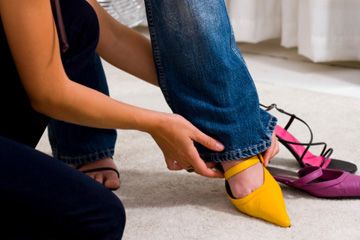For some people, shopping in thrift stores is simply a way to stretch a budget, score a Halloween costume or satisfy a momentary lapse into kitsch. I, however, am not most people. For me, thrifting is not just some cheap way to furnish my apartment or recapture my youth — it is a way of life. With a pull greater than a marathon of the Real World, the opportunity to thrift, and all the delicious possibilities that go with it, is an obsession that only few understand. These are the same people who recognize the intrinsic value of a vintage paint-by-number collection. These are the same people who, incidentally, are not my husband.
My two decades of rooting through musty paperbacks and chipped Fiestaware has left me with a few coups (a mint-condition Steiff teddy bear for 75 cents and a $7 Gucci handbag come to mind).
Advertisement
But more than that, living and breathing secondhand air has taught me some valuable tricks when it comes to the art of the deal.
Where to Thrift
While thrifting allows you to give in to the urge to consume while still holding on to your savings, where you thrift has an impact on what you will consume. The general rule of thumb is: the better the neighborhood, the more disappointing the thrift. Stores run by well-bred charities like the Junior League tend to be filled with uninteresting stuff — casserole dishes, bad polyester, old hi-fi systems.
Since thrift stores tend to move into places with low overhead, the best ones are in the sketchier parts of town. Check the Yellow Pages of your local phone book. Or, if you're feeling more adventuresome, try driving around near the train or bus station.
How to Thrift
One of the best pieces of advice comes from Al Hoff, publisher of the Pittsburgh, Pa.-based zine Thrift Score. She urges beginners to shop the store, not the department. At best, thrift stores are in poor order, the best ones being the most disorganized. Between busy staff and inconsiderate shoppers, merchandise ends up in the strangest places: tennis racquets in women's outerwear, games in kitchen appliances, etc.
When to Thrift
Once you find a store you like, stay loyal to it. Frequent visits will help establish what I call the "thrift cycle." How often does the staff replenish the merchandise and on what days? Make friends with a staffer. Tell them what sorts of items you're interested in and ask them to call you if any, say, antique beaded pocketbooks ever show up.
What to Thrift
Most importantly, if you're hoping to find a Fendi baguette for a dollar or a 16th-century prayer rug in the half-price bin, forget about it. These kinds of treasures are rare and require endless and patient searching. To truly earn a thrift score, the trick is to buy things before they're considered collectible. Become a visionary. Today's Happy Meal premiums could command premium prices tomorrow.
But the best advice when it comes to thrift shopping is to buy what you like. If you buy those occupied-Japan salt and pepper shakers hoping to turn a profit, you're missing the whole point of thrifting. It's not what something is worth — it's what it's worth to you.
Advertisement


